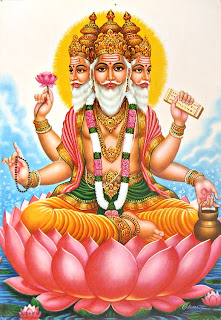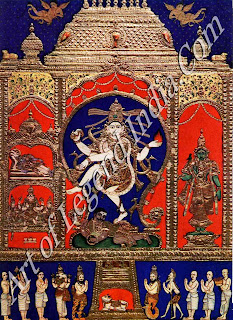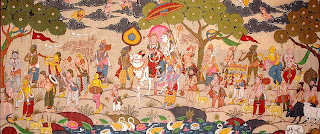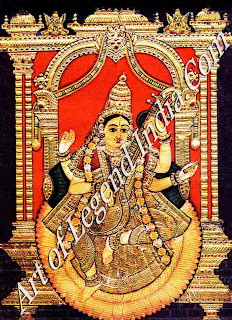Hinduism
is not based on any single book nor on the words of any single teacher or
prophet. It is based on the Eternal Truth.
However
there are, literally, thousands of books and scriptures to guide both the
beginner and the scholar, verily a cornucopia of spiritual literature.
The Srutis
The
first set of books, which are the primary authority or the very soul of
Hinduism, are known as "Sruti", meaning that which has been heard or
revealed. These Srutis are known as the Vedas. The word 'Veda' is derived from
the word 'vid', to know, and the Vedas are holy or spiritual knowledge of the
Eternal Truth. The word `Rishi' is derived from the word dris', to see. The
Rishis were the Seers or Sages to whom the Vedas were revealed by Divine
intervention and in whose hearts and minds they were heard. The Vedas are
apaurusheya (of divine origin) and are unchangeable and eternal. They teach the
highest truths ever known to man, and are valid for all time and all ages.
Hindus
believe that Creation is anadi (that which has no beginning) and that it is
eternal. At the end of each kalpa (a unit of time equal to a day of Brahma, the
Creator, amounting to 4.320 million earth years), it exists in a subtle form in
God, from whence each time is recreated a new Universe. At the end of the last
age, there was a great deluge or pralaya, which destroyed the Universe. Brahma,
the Creator, is believed to have meditated at the dawn of this age, called the
Swetavaraha Kalpa, when the Great God appeared in the form of the sound of OMEhhgggffhdsfgdyhgrutth also
known as the Pranava. (OM, as the symbol of the Absolute, is therefore the most
sacred symbol of Hinduism.)
Brahma
then prayed to Him for knowledge to create a new Universe. From the vibrations
of the sound of OM (also spelt AUM), the Lord conceived the Rig Veda, the Yajur
Veda, the Sama Veda and the Atharva Veda. The Great God then taught these four
Vedas to Brahma who created our present Universe with this supreme knowledge
received by him. In other words, the Vedas existed even before the creation of
our universe.
 Sage
Veda Vyasa codified the four Vedas. His disciples, Paila, Vaisampayana, Jaimini
and Sumanta taught them to their disciples and the latter, in turn, to their
pupils. This is how the Vedas have come to us through thousands of years. They
are therefore called amnaya, or that which has come to us by tradition.
Sage
Veda Vyasa codified the four Vedas. His disciples, Paila, Vaisampayana, Jaimini
and Sumanta taught them to their disciples and the latter, in turn, to their
pupils. This is how the Vedas have come to us through thousands of years. They
are therefore called amnaya, or that which has come to us by tradition.
The Rig
Veda consists mostly of hymns in praise of the Divine, the Yajur Veda mainly of
hymns used in religious rituals and rites, the Sama Veda of verses from the Rig
Veda set to music, and the Atharva Veda guides man in his material and daily
living.
The
Vedas have several parts. They are the mantra (or hymns), the Brahmana (or the
explanatory treatises for using mantras in rituals), the Aranyaka or forest
books (which are the mystical interpretations of the mantras and rituals), and
the Upanishad. The Upanishads are the most important part of the Vedas, as it
is believed that knowledge of the Upanishads brings about the destruction of
avidya or ignorance, one of the greatest failings of mankind.
There
are about 108 Upanishads in all. Of these, 12 are the most important the Isa, Kena,
Katha, Prasna, Mundaka, Mandukya, Aitareya, Taittiriya, Chandogya,
Brihadaranyaka, Kaushitaki and Svetasvatara.
The
Upanishads reveal some of the greatest truths ever known to mankind. They
contain the essence of the philosophy of the Vedas and the profound spiritual
truths contained in them have blazed through the ages, guiding Man in his
search for spiritual enlightenment.
The
next sets of books are the Upa Vedas or the Subsidiary Vedas, which are four in
number. The first is Ayurveda, the science of extending life, including in its
study the systems of maintaining good health and the use of medicines derived
from herbs, roots and fruits. Highly developed in ancient India, this science
of Indian medicine and pharmacology had the positive side of promoting health,
the curative side consisting of the treatment of diseases, and a highly
developed school of surgery. Many medicines of the ancient Hindus have since
been adapted into the European medical system and are in use to this day.
Charaka,
the greatest of ancient Hindu physicians, was possibly the first to speak of a
code of ethics for the physician to treat patients without thought of gain or
reward, and to keep in strict confidence the illness of a patient.
. Sushruta,
the great surgeon of ancient India, mentions 120 surgical instruments in use at
that time. Plastic surgery was a well-developed science as was the art of
setting right deformed parts of the body such as the ears, nose and lips. The
latter skill was taken from India to the West by the surgeons of the British
East India Company as late as in the 18th century.
Sushruta,
the great surgeon of ancient India, mentions 120 surgical instruments in use at
that time. Plastic surgery was a well-developed science as was the art of
setting right deformed parts of the body such as the ears, nose and lips. The
latter skill was taken from India to the West by the surgeons of the British
East India Company as late as in the 18th century.
The
second Upa Veda is the Dhanurveda, the science of archery and the use of
weapons. Even weapons like missiles are covered in this ancient treatise.
However the rules of warfare were strictly laid down, and the use of such
weapons was permitted only for the destruction of evil and for the protection
of the physically weak, of sages in meditation, of holy men and mendicants, of
women and children.
Even
during warfare, rules and regulations were strictly observed. For example,
opposing armies laid down their arms at sunset and dined together amicably,
commencing hostilities only at sunrise the next day.
The
third Upa Veda, the Gandharva Veda, is the science of music and dance. The sage
Bharata has written the Natya Shastra, the oldest book in the world on this
subject. He is believed to have been taught by Sage Tandu after the latter
witnessed the cosmic dance of Lord Shiva.
The
recitation of the Vedas, especially of the musical Sama Veda, placed great
emphasis on musical notation and sound, and as they were learnt by rote by word
of mouth, the science of sound and acoustics, with emphasis on musical
chanting, reached high standards of perfection. The earliest musical octave was
accurately divided into 22 quarter tones. Musical instruments of ancient India
included a wide variety of percussion instruments (drums), wind instruments
(such as the flute), and stringed instruments (such as the vina), many of which
have survived to this day.
 Music
was considered a method of reaching God-head. The Veda of the Hindus and the
Zend-Avesta of the Zoroastrian religion are the earliest known instances of
words set to music.
Music
was considered a method of reaching God-head. The Veda of the Hindus and the
Zend-Avesta of the Zoroastrian religion are the earliest known instances of
words set to music.
The
fourth of this series of Upa Vedas is the Arthashastra. This is a treatise on
polity, state administration, and the conduct of commerce.
We then
have the Vedangas, the explanatory limbs of the Vedas. The first, called
Siksha, was written by Sage Panini. It is the science of phonetics and also
deals with pronunciation and accent.
Panini
also authored another Vedanga, Vyakarana, the science of grammar. Panini's
commentaries on this subject guide students of the Sanskrit language to this
day.
The
third Vedanga is Nirukta, the science of the etymology of the words in Vedic
Mantras. It is the science of linguistics dealing with the formation and
meanings of words.
The
fourth, the Chandas Shastra, teaches prosody, the art of versification, and
deals with the use of metres in prose and poetry.
The
Kalpa Shastra deals with the science of rituals and ceremonials in religious
rites.
The
last Vcdanga is Jyotisha, the science of astronomy and astrology. Knowledge of
astrology was utilised in ancient India to fix auspicious timings for events of
peace and war. It was only after the 6th century that this school of study gave
importance to predictions on the future of individuals, which have become the
craze today.
The
world owes much to Indian mathematics, which knowledge was conveyed to the Arab
and the Greek worlds. The concept of zero (or sunya), abstract concepts of
numbers, algebra, the decimal system, all owe their origin to the ancient
Hindus. The Isavasya Upanishad taught, as a philosophical concept, the
revolutionary mathematical truth that Infinity divided by any number continues
to be Infinity.
Astronomy
was the more important branch of the science of Jyotisha and the ancient
Hindus, with their mathematical excellence, sent their advanced theories to
Europe through the Greeks. Aryabhata, the ancient Indian astronomer, opined
that it was not the sun that moved round the earth but the earth which, on its
axis, rotated around the sun. Knowledge of the equinoxes, the movements of the
sun and the moon, and fantastically accurate predictions of eclipses are
evidence of the depth of study of the ancient astronomers. The open-air
observatory at Jaipur with its minutely accurate instruments is an indication
of what its precursors must have been.
Writer – Shaunthala Jagannathan
 Sage
Veda Vyasa codified the four Vedas. His disciples, Paila, Vaisampayana, Jaimini
and Sumanta taught them to their disciples and the latter, in turn, to their
pupils. This is how the Vedas have come to us through thousands of years. They
are therefore called amnaya, or that which has come to us by tradition.
Sage
Veda Vyasa codified the four Vedas. His disciples, Paila, Vaisampayana, Jaimini
and Sumanta taught them to their disciples and the latter, in turn, to their
pupils. This is how the Vedas have come to us through thousands of years. They
are therefore called amnaya, or that which has come to us by tradition.  Sushruta,
the great surgeon of ancient India, mentions 120 surgical instruments in use at
that time. Plastic surgery was a well-developed science as was the art of
setting right deformed parts of the body such as the ears, nose and lips. The
latter skill was taken from India to the West by the surgeons of the British
East India Company as late as in the 18th century.
Sushruta,
the great surgeon of ancient India, mentions 120 surgical instruments in use at
that time. Plastic surgery was a well-developed science as was the art of
setting right deformed parts of the body such as the ears, nose and lips. The
latter skill was taken from India to the West by the surgeons of the British
East India Company as late as in the 18th century.  Music
was considered a method of reaching God-head. The Veda of the Hindus and the
Zend-Avesta of the Zoroastrian religion are the earliest known instances of
words set to music.
Music
was considered a method of reaching God-head. The Veda of the Hindus and the
Zend-Avesta of the Zoroastrian religion are the earliest known instances of
words set to music.












0 Response to "The Scriptures of the Hindus"
Post a Comment